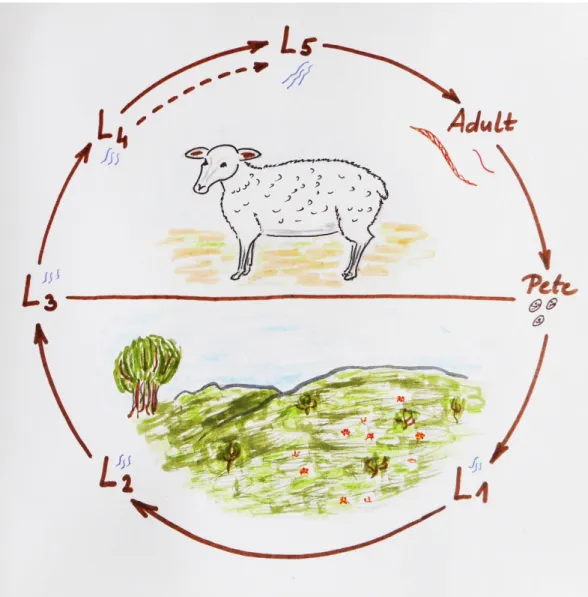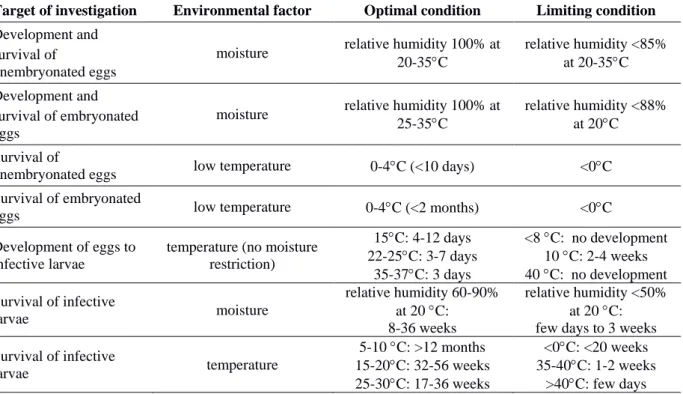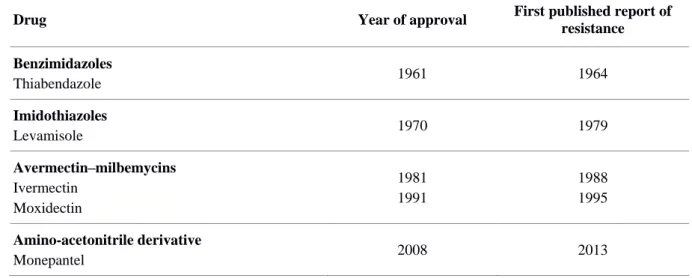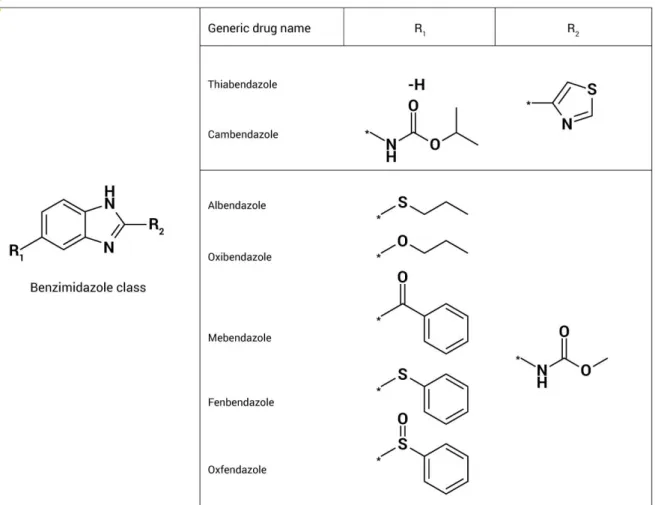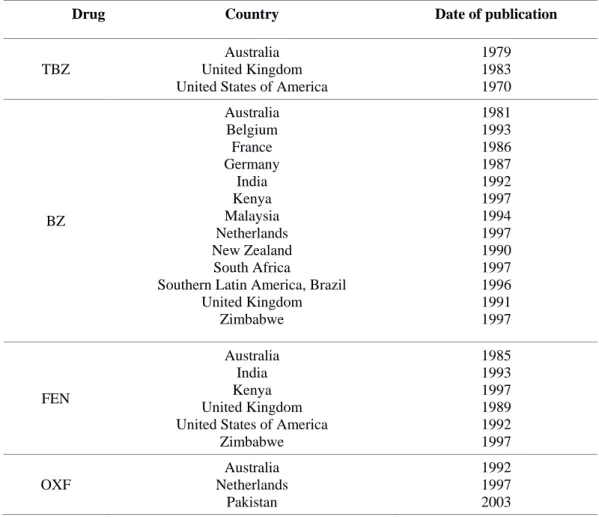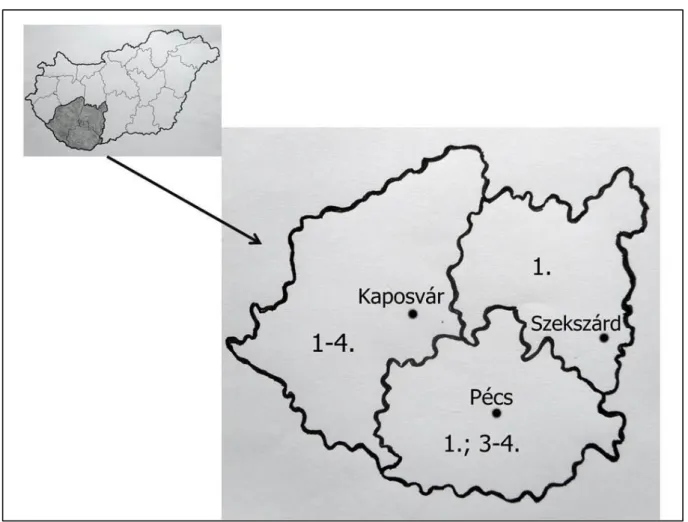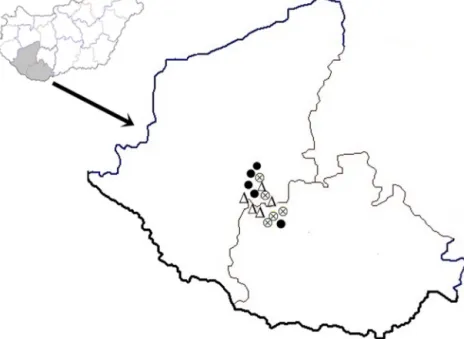THESIS
GÁBOR NAGY
KAPOSVÁR UNIVERSITY FACULTY OF AGRICULTURAL AND ENVIRONMENTAL SCIENCES
2019
Click to BUY NOW!
.tracker-software.c Click to BUY NOW!
.tracker-software.c
Click to BUY NOW!
.tracker-software.c Click to BUY NOW!
.tracker-software.c
KAPOSVÁR UNIVERSITY
FACULTY OF AGRICULTURAL AND ENVIRONMENTAL SCIENCES DEPARTMENT OF WILDLIFE BIOLOGY AND ETHOLOGY
The Head of Doctoral (Ph.D.) School:
PROF. DR. MELINDA KOVÁCS member of the HAS
Supervisors:
PROF. DR. LÁSZLÓ SUGÁR CSc, professor emeritus
DR. ATTILA ZSOLNAI PhD, scientific advisor,
Research Institute for Animal Breeding, Nutrition and Meat Science, Herceghalom
Written by:
GÁBOR NAGY
BENZIMIDAZOLE RESISTANCE IN HAEMONCHUS CONTORTUS IN DOMESTICATED AND WILD RUMINANT POPULATIONS IN SOUTHWESTERN
HUNGARY
Kaposvár 2019
DOI: 10.17166/KE2019.016
Click to BUY NOW!
.tracker-software.c Click to BUY NOW!
.tracker-software.c
Click to BUY NOW!
.tracker-software.c Click to BUY NOW!
.tracker-software.c
i
TABLE OF CONTENT
ABBREVIATIONS ... iii
1. REVIEW OF THE LITERATURE ... 1
1.1. Haemonchus contortus and haemonchosis in small ruminants ... 1
1.1.1. Taxonomy and life cycle ... 1
1.1.2. Geographical distribution ... 2
1.1.3. Environmental factors affecting the free-living stages ... 3
1.1.4. Clinical symptoms, diagnosis ... 4
1.2. Benzimidazoles as anthelmintics ... 4
1.2.1. Overview of benzimidazoles ... 4
1.2.2. Resistance to benzimidazoles... 6
1.2.3. Methods for detection of benzimidazoles resistance ... 7
1.3. Nematode cross-transmission between domesticated and wild ruminants ... 8
2. CONCLUSIONS DRAWN FROM THE DATA OF THE LITERATURE... 11
3. ANTECEDENTS AND OBJECTIVES OF THE DISSERTATION ... 13
4. METHODOLOGICAL SUMMARY OF THE DISSERTATION ... 15
4.1. Study sites ... 16
4.2. Parasitological procedure ... 17
4.3. DNA extraction and molecular diagnostic procedure ... 19
4.4. Statistical methods ... 20
5. CHAPTERS ... 21
5.1. CHAPTER 1 ... 21
5.2. CHAPTER 2 ... 28
5.3. CHAPTER 3 ... 34
5.4. CHAPTER 4 ... 39
6. GENERAL DISCUSSION ... 43
7. CONCLUSIONS ... 53
8. NEW SCIENTIFIC RESULTS ... 55
9. SUMMARY ... 56
10. ÖSSZEFOGLALÁS ... 58
11. ACKNOWLEDGEMENTS ... 60
12. REFERENCES ... 61
13. PUBLICATIONS AND PRESENTATIONS ... 72
14. CURRICULUM VITAE ... 76
Click to BUY NOW!
.tracker-software.c Click to BUY NOW!
.tracker-software.c
ii
Click to BUY NOW!
.tracker-software.c Click to BUY NOW!
.tracker-software.c
iii
ABBREVIATIONS
AR anthelmintic resistance
BZ benzimidazole
ABZ albendazole
ABZSO albendazole-sulphoxide
DNA deoxyribonucleic acid
EHT egg hatch test
FECRT faecal egg count reduction test
FEN fenbendazole
GIN gastrointestinal nematode
H Shannon diversity index
H. contortus Haemonchus contortus
I importance index
IVM ivermectin
L1 first stage nematode larva
L2 second stage nematode larva
L3 third stage nematode larva
L4 fourth stage nematode larva
L5 fifth stage nematode larva
MBZ mebendazole
PCR polymerase chain reaction
R resistant
Click to BUY NOW!
.tracker-software.c Click to BUY NOW!
.tracker-software.c
iv
RFLP-PCR restriction fragment length polymorphism-
polymerase chain reaction
RR homozygous resistant
RS heterozygous
S susceptible
SC Sorensen coefficient
SNP single nucleotide polymorphism
SS homozygous suscptiblet
OXF oxfendazole
TBZ thiabendazole
Click to BUY NOW!
.tracker-software.c Click to BUY NOW!
.tracker-software.c
1
1. REVIEW OF THE LITERATURE
1.1. Haemonchus contortus and haemonchosis in small ruminants 1.1.1. Taxonomy and life cycle
Haemonchus contortus (Phylum: Nematoda; Order: Strongylida; Superfamily:
Trichostrongyloidea; Family: Trichostrongylidae; Subfamily: Haemonchinae; Genus:
Haemonchus) is a blood-feeding and highly pathogenic parasite live on the abomasal mucosa.
They can infect a wide range of hosts, such as Bovidae, Cervidae, Camelidae, Giraffidae and Antilocapridae (Anderson, 2000; Kassai, 2003; Hoberg et al., 2004).
H. contortus, as known as barber’s pole worm in English literature, has a direct life cycle. The adult worms live inside the abomasum of the host, where the fecund females produce a large number of eggs. The morulated eggs excrete via faeces and in optimal environmental condition can hatch within 1 day. After 2 moults the hatched L1 larvae develop to the infective L3. The specimens of this stage can move horizontally and vertically on the vegetation and the ground. The L3s ingested by the host, and in its abomasum moult to L4. In this phase, the larvae development could continue in two different manners. The first is a continuous development to L5, subadult and adult stages, while the worms become fertile and after copulation, the females lay eggs. In this case, the prepatent period is 3-4 weeks (Figure 1).
The second manner is hypobiosis. Hypobiosis is the most useful life cycle adaptation to ensure persistence and has been reported in most of the Trichostrongylid nematodes parasitizing small ruminants. It facilitates the synchronization of the nematode life cycle to changing host and unfavourable environmental conditions. It allows H. contortus (barber’s pole worm) to survive until more favourable conditions resume. (Gibbs, 1986; Kassai, 2003;
Taylor et al., 2016). In favourable environmental circumstances, the development of hypobiotic larvae proceeds as it was shown above.
Click to BUY NOW!
.tracker-software.c Click to BUY NOW!
.tracker-software.c
2
Figure 1. The direct life cycle of H. contortus (barber’s pole worm) 1.1.2. Geographical distribution
H. contortus is originated in the sub-Saharan region of Africa. The domestication of artiodactyls and the very intensive sheep (Ovis aries), goat (Capra aegagrus hircus), cattle (Bos taurus) translocation since the 1500s, were the core associations for the global distribution of the helminth (Hoeberg et al., 2004). Although the presence of the worm is more considerable in tropical and subtropical climatic zones in both hemispheres, the species has a remarkably adaptive strategy over a colder and dryer environment. Due to the high biotic potential, the H. contortus is able to successfully conform to the colder, dryer climates, where just a short, favourable period exists for the development of its free-living stages (Waller and Chandrawathani, 2005; O’Connor et al., 2006).
This adaptive mechanism is well confirmed by Troel et al. (2006) and Falzon et al.
(2014). These results suggested that infective (L3) H. contortus larvae could be able to over-
Click to BUY NOW!
.tracker-software.c Click to BUY NOW!
.tracker-software.c
3
winter on pasture in the temperate and cold climate zones of the northern hemisphere. This phenotypic trait was regardless of tropical or cold zone origin of the larvae. Although the surviving rate was lower than other important parasite genera such as Teladorsagia spp., Nematodirus spp., and Trichostrongylus spp., this cold tolerant trait may contribute to the continuous infection.
The increasing presence and common occurrence of H. contortus in various temperate and sub-polar climate zones, the hypobiosis or arrested development is the keystone of continuous perpetuance (Waller et al., 2004).
1.1.3. Environmental factors affecting the free-living stages
The zonal distribution and seasonal epidemiological characteristics of H. contortus reflect on the major climatic variables affecting the development and survival of free-living stages. The main determinants of developmental success are undoubtedly temperature and moisture, and of course, some other factors (e.g. vegetation, light intensity) might also have importance (O’Connor et al., 2006). The optimal development requirements in the four free- living stages differ (Table 1).
Table 1: Effects of environmental factors on the free-living stages of Haemonchus contortus under controlled conditions (adapted from Gasser and von Samson-Himmelstjerna, 2016)
Target of investigation Environmental factor Optimal condition Limiting condition Development and
survival of
unembryonated eggs
moisture relative humidity 100% at
20-35C relative humidity <85%
at 20-35C Development and
survival of embryonated eggs
moisture relative humidity 100% at
25-35C relative humidity <88%
at 20C Survival of
unembryonated eggs low temperature 0-4C (<10 days) <0C Survival of embryonated
eggs low temperature 0-4C (<2 months) <0C
Development of eggs to infective larvae
temperature (no moisture restriction)
15C: 4-12 days 22-25C: 3-7 days
35-37C: 3 days
<8 C: no development 10 C: 2-4 weeks 40 C: no development Survival of infective
larvae moisture
relative humidity 60-90%
at 20 C:
8-36 weeks
relative humidity <50%
at 20 C:
few days to 3 weeks Survival of infective
larvae temperature
5-10 C: >12 months 15-20C: 32-56 weeks 25-30C: 17-36 weeks
<0C: <20 weeks 35-40C: 1-2 weeks
>40C: few days
Click to BUY NOW!
.tracker-software.c Click to BUY NOW!
.tracker-software.c
4 1.1.4. Clinical symptoms, diagnosis
Among the gastrointestinal nematodes of small ruminants, Haemonchus contortus has almost the most overwhelming importance. Owing to the fecundity, genetic diversity, and the very adaptive phenotypic plasticity, this abomasal bloodsucking worm may be the most important invader parasite in sheep and goats. This species causes enormous economic losses, health problems and frequently increases the mortality rate in the host populations. H.
contortus has shown a great ability to develop anthelmintic resistance (AR) which has emerged in all countries of the world that produce small ruminants (Waller and Chandrawathani, 2005; Papadopulos et al., 2012; Barrere et al., 2013; Roeber et al., 2013).
The symptoms of H. contortus infection relate almost entirely to the blood-feeding activities of adult and/or L4, L5 larval stages (Taylor et al., 2016). Depending on the worm/larvae number, the haemonchosis can be categorised as a hyperacute, acute, and chronic infection. In hyperacute form, the symptoms are a massive blood loss, haemorrhagic gastritis, and terminal anemia. In such a case, the parasite number exceeds 25-30 000 specimens. The acute haemonchosis develops ingesting numerous L3 after 4-6 weeks post- infection. The worm burdens of 2000-20 000 worms per host. It is characterised by severe anaemia, variable degrees of oedema, of which the submandibular form (‘bottle jaw’), and ascites are the most easily recognised symptoms, while lethargy, dark-coloured faeces, and falling wool might be also detected. In the temperate climatic regions, the most prevalent form is a chronic infection. Chronic haemonchosis is associated with progressive weight loss, weakness, neither severe anaemia nor gross oedema. The performance (weight gain, milk production) decreases and manifests similarly as malnutrition (Gasser and von Samson- Himmelstjerna, 2016; Taylor et al, 2016).
1.2. Benzimidazoles as anthelmintics 1.2.1. Overview of benzimidazoles
In the grazing livestock, agriculture has been depending heavily on the routine application of broad-spectrum anthelmintics. Nowadays, just four broad-spectrum anthelmintic classes can be found, namely the benzimidazoles (BZs), the imidazothiazoles, the macrocyclic lactones and the monepantel (Kaplan, 2004; Kaminsky et al., 2008). Due to
Click to BUY NOW!
.tracker-software.c Click to BUY NOW!
.tracker-software.c
5
the intensive use of these drugs resulted in the rapid appearance of AR in small ruminants (Table 2).
Table 2. Broad spectrum athelmintic classes and appearance of resistance in sheep. (Adapted from Kaplan (2004).
Drug Year of approval First published report of
resistance
Benzimidazoles
Thiabendazole 1961 1964
Imidothiazoles
Levamisole 1970 1979
Avermectin–milbemycins Ivermectin
Moxidectin
1981 1991
1988 1995 Amino-acetonitrile derivative
Monepantel 2008 2013
In veterinary practice, one of the most preferred drug groups is BZs, due to their advantageous properties; such as high therapeutic index, the absence of toxic residuals in milk and meat and economical availability (Tiwari et al., 2006). The usage of albenzimidazole (ABZ) is surpassing in the sheep farming practice, although the group contains several drugs (Figure 2).
The primary effect of BZs is disruption of the tubulin microtubule-equilibrium.
Microtubules have a fundamental role in the maintenance of cellular homeostasis in eukaryotic cells. Through binding of BZ molecules to the β-tubulin monomer, the proliferation of polymeric microtubules by addition of α-/β-tubulin heterodimers is inhibited, which can cause energy deficiency (von Samson-Himmelstjerna et al., 2007).
Click to BUY NOW!
.tracker-software.c Click to BUY NOW!
.tracker-software.c
6
Figure 2. Representatives of BZ class (Adopted from: Anonymous, 2007)
1.2.2. Resistance to benzimidazoles
It is accepted, that AR is a pre-adaptive heritable phenomenon coded in a gene or genes. It could be present within the parasite population even prior to the drug being used for the first time. The appearance of drug resistance facilitates an increase in the frequency of individuals able to tolerate elevated drug doses relative to a normal population, therefore reflects changes in the composition of a parasite population gene pool (Beech et al., 1994). In the last decades, one of the most threatening factors for grazing, especially in small ruminants is AR (Rose et al., 2015). For this reason, the level of BZ resistance in H. contortus all over the word is a living problem (Jabbar et al., 2006) (Table 3).
Click to BUY NOW!
.tracker-software.c Click to BUY NOW!
.tracker-software.c
7
Table 3. Resistance to BZs in H. contortus reported in different parts of the world (Adopted from Jabbar et al., 2006)
Drug Country Date of publication
TBZ
Australia United Kingdom United States of America
1979 1983 1970
BZ
Australia Belgium France Germany
India Kenya Malaysia Netherlands New Zealand South Africa
Southern Latin America, Brazil United Kingdom
Zimbabwe
1981 1993 1986 1987 1992 1997 1994 1997 1990 1997 1996 1991 1997
FEN
Australia India Kenya United Kingdom United States of America
Zimbabwe
1985 1993 1997 1989 1992 1997 OXF
Australia Netherlands
Pakistan
1992 1997 2003
BZ = Benzimidazole; MBZ = Mebendazole; FEN = Fenbendazole; TBZ = Thiabendazole;
OXF = Oxfendazole
1.2.3. Methods for detection of benzimidazoles resistance
The most common, practical, in vivo BZ resistance detection method is the faecal egg count reduction test (FECRT), which compares the egg count before and after treatment with the anthelmintic drug. The egg hatch test (EHT) is an in vitro test, which is proper only for the detection of BZ resistance. Its usage can assess the ovicidal activity of this molecule group.
Both of these tests have a considerable disadvantage, the sensitivity. FECRT and the EHT are capable to detect resistance only when at least 25% of the worm population carries resistance genes (Martin et al., 1989). Although there are some other time consuming and labour intensive in vitro tests, as larval development test, adult development test, adult motility test, their application is confined, because of cost, applicability, interpretation or reproducibility of findings (Jabbar et al., 2006).
Click to BUY NOW!
.tracker-software.c Click to BUY NOW!
.tracker-software.c
8
It is generally accepted that mutations in the β-tubulin genes are the major determinants of BZ resistance. Two genes, isotypes 1 and 2, were isolated and correlated with resistance. To our present knowledge, it seems that 3 different SNPs (Single Nucleotide Polymorphism: i.e., Phe200Tyr, Phe167Tyr or Phe167His, and Glu198Ala) in the isotype-1 β- tubulin can be responsible mostly for BZ resistance. A thymine-to-adenine transversion causes a substitution of phenylalanine with tyrosine at codon 200 of the isotype 1 protein (Kwa et al., 1994). This mutation is widespread all over the world, therefore (Coles et al., 2006). At position 167, one allele is being associated with BZ resistance in H. contortus Prichard, 2001). This polymorphism involves a substitution of phenylalanine with tyrosine, but also substitution of phenylalanine with histidine. The last detected mutation in isotype 1 can also contribute to BZ resistance in H. contortus described by Ghisi et al. (2007); it is known as an adenine-to-cytosine transversion that leads to a glutamate-to-alanine polymorphism at codon 198 in BZ-resistant populations from Australia and South Africa.
Several PCR protocols have been developed, which provide high accuracy and sensitivity when used to investigate the AR. These methods are able to detect 1% of resistant individuals within a susceptible worm population, which is a tremendous improvement comparing to in vivo and in vitro tests (Roos et al., 1995). By using a representative number of sample, the allele-specific PCR, real-time PCR, restriction fragment length polymorphism- PCR and sequencing can provide reliable results about the resistance status of a given worm population.
1.3. Nematode cross-transmission between domesticated and wild ruminants
Disease transmission between wild and domesticated ruminants has many important aspects. Its incidence can affect the population dynamics of wild games and sometimes can cause serious economic problems in animal husbandry (Martin et al., 2011). The agents of these diseases are predominantly microparasites (viz prions, viruses, and bacteria); and a merely smaller amount is caused by macroparasites in the wildlife-livestock interface (Wiethoelter et al., 2015). Although the nematodes of domestic ruminants have very exiguous importance in human parasitic infections; but on occasion, those could emerge in well confinable areas (Holló et al., 1970; Vilimszky and Szigethiné, 1971; Sato et al., 2011). The economic losses derived from clinical and subclinical gastrointestinal nematode infection are enormous problems all over the world. The induced damages have been derived mainly by
Click to BUY NOW!
.tracker-software.c Click to BUY NOW!
.tracker-software.c
9
decreasing meat and milk production, fertility rate, and increased susceptibility to other bacterial or viral diseases. In wild ruminant populations, parasites have pronounced effects on individual productivity; which could affect population dynamics (Gunn and Irvine, 2003;
Roeber et al., 2013; Walker and Morgan, 2014).
In grazing systems shared between wild and domesticated ruminants, the cross- infection could occur in both directions (Zaffaroni et al., 2004; VanderWaal et al., 2014;
Walker and Morgan, 2014). Preston et al. (1979) infected Thomson’s gazelle (Eudorcas thomsonii) by sheep-derived mixed gastrointestinal nematode (GIN) larvae. After 4 weeks, Haemonchus contortus was the only species recovered during necropsy. Similar results were observed in an experiment when the authors infected white-tailed deer with H. contortus recovered from sheep. The established worms affected significantly the haematological parameters (packed cell volume, haemoglobin, and total serum protein) and caused severe infection in fawns (McGhee et al.,1981). In Tapia-Escárate et al’s investigation (2015), red deer (Cervus elaphus) calves were infected with mixed, sheep-originated gastro-intestinal nematode (GIN) larvae. After 4 weeks, the animals were euthanized and dissected to collect GIN from their alimentary tracts. They concluded that Haemonchus, contortus, Teladorsagia circumcincta, Cooperia curticei, Trichostrongylus axei and Oesophagostomum venulosum were able to establish infection. The results of the abovementioned studies may suggest that only some generalist nematodes (eg Haemonchus contortus) could establish and configure stable metapopulation in wild hosts.
On the other hand, wild species could also infect domestic ones in different circumstances. In field conditions, a serious setariosis was observed between 2003 and 2005 in Finnish, semi-domesticated reindeer (Laaksonen et al., 2009). The clinical symptoms (peritonitis) were caused by Setaria tundra derived from free-range roe deer (Capreolus capreolus) and reindeer (Rangifer tarandus) populations.
A similar direction of infection was detected in Poland by molecular diagnostic tools.
The transmission of Ashworthius sidemi infection from wildlife to domestic animals has confirmed on a natural pasture shared by cattle, sheep and wild ruminants (Moskwa et al., 2015). The results suggested the worm presence in cattle herds and verified the transfer from wild ruminants to domesticated ones.
In the experiment of Handeland et al. (2000), Elaphostrongylus cervi L3 larvae were used to infect small ruminants. As a consequence of larvae migration, inflammation and
Click to BUY NOW!
.tracker-software.c Click to BUY NOW!
.tracker-software.c
10
necrosis were observed in the central nervous system and other organs, although adult nematodes and patent infections were not observed.
An experimental infection of sheep using nematode larvae recovered from the faeces of naturally infected endangered Swayne’s Hartebeest (Alcelaphus buselaphus swaynei) was carried out by Desta et al. (2014). After necropsy; from the abomasums, Haemonchus placei while from the large intestine, Oespophagostomum venulosum and Trichuris spp. were identified; and the authors demonstrated that transmission of helminths between Swayne’s hartebeest and sheep is experimentally possible. Analogous results were found in a roe deer- sheep-cattle model by Chintoan-uta et al. (2014) when roe deer-derived GIN larvae were used to infect a calf and it has resulted in a successful establishment and infection. After 21 days, faeces from the calf was collected and used for larval culture and extraction to infect a single lamb. The experimental animals were slaughtered at the end of the study and abomasal nematodes were collected. The authors recovered H. contortus, Spiculopteragia spiculoptera and Ostertagia leptospicularis from the calf and H. contortus and Ostertagia leptospicularis from the sheep. It was concluded that wild roe deer have the potential to acquire GIN (mainly H. contortus) from cattle and sheep.
As the abovementioned shows it, the helminthic cross-infection is an existing phenomenon between different host species and may play a role in the spread of resistance allele also in a habitat overlapped by domesticated and wild ruminants.
Click to BUY NOW!
.tracker-software.c Click to BUY NOW!
.tracker-software.c
11
2. CONCLUSIONS DRAWN FROM THE DATA OF THE LITERATURE
Arguably, the presence of Haemonchus contortus populations is one of the most important threatening factors in the small ruminant sector. Due to its high pathogenicity and the unique phenotypic plasticity driven by a considerable genetic diversity, this parasite causes huge production losses and socio-economic problems globally, each year. Although this bloodsucking helminth is originated as a tropical species, today, however, its spatial distribution covers all of the climatic zones excepting the polar regions. The climate change, raising mean temperature and other weather anomalies can provide more and more capable habitats for surviving of free-living stages.
Decrease the losses caused by GIN, anthelmintic treatments and chemo-prophylaxis could be efficacious tools. Until now, just a few broad-spectrum drug classes are available for control. The oldest one, benzimidazoles, was introduced almost 60 years ago, while the youngest one, amino-acetonitrile derivative, is accessible since 2008. Unfortunately, these relatively inexpensive drugs became the only weapon in the battle against the endoparasites.
Their solely and frequent application resulted in the occurrence and spread of AR within a few years in every class. Nevertheless, these obvious facts are well-known in several regions of the World; the level of AR in Hungarian sheep sector is absolutely unidentified. The lack of this information can cause not just economic and animal health problem in the sector but hamstrings the efficient GIN control.
The molecular diagnostic methods are very useful tools for a rapid and accurate approach of the routine diagnosis of GIN infections in the sheep farming practice. They could combine with conventional tests (e.g. FECRT, in vitro assays) to recognise the early appearance and dispersion of AR in the worm populations.
The grazing lands are fundamental resources of the small ruminant production systems. Due to their naturality, the included habitats are shared many times between wild and domestic ungulate species. This mutual exploitation can generate the potential for transmission of parasitic nematodes between host populations. Studies of GIN transmission at the wildlife/livestock interface rarely discussed; although they could induce strong effects in health, production, and population dynamics. Some studies verified the possibility of H.
contortus cross-infection between different types of ruminants in natural circumstances.
Confirmed by genotyping (Cerutti et al., 2010), H. contortus strains were well mixed between
Click to BUY NOW!
.tracker-software.c Click to BUY NOW!
.tracker-software.c
12
wild and domestic ungulate hosts, and it was concluded this transmission occurs in shared pastures regularly.
To date, few studies have been accomplished to confirm the potential role of cervids in carrying and spreading of AR nematodes. AR H. contortus were found in free-living, untreated roe deer and successfully transmitted experimentally to sheep and cattle. These results indicating, that deer could contribute to the spread of AR in natural circumstances.
Click to BUY NOW!
.tracker-software.c Click to BUY NOW!
.tracker-software.c
13
3. ANTECEDENTS AND OBJECTIVES OF THE DISSERTATION
Hungarian sheep farming has a very important socio-economic role, mainly in the less-developed rural region. For sufficient incomes, the farmers should maintain well- managed flocks. In this process, the parasite control has a core role. Unfortunately, parasitological status and the level of AR in Hungarian sheep sector are absolutely unidentified. The lack of this information can cause not only economic and animal health problem in the sector but hamstrings the efficient GIN control.
The Game Management Landscape Centre of the Kaposvár University has one of the most important red deer stocks in Middle-Europe. In 1300 hectare, more than 1500 red deer are managed for venison and hunting purposes. This animal density is much higher than in the neighbouring natural habitats. Without drug application against micro and macroparasites, the economic aims proposed by the management are unimaginable.
Our co-operation with the SEFAG Forest Management and Wood Industry Share Co.
dates back to 2007. In its framework, we have been monitoring the stock of game managed by the firm. This surveillance covers all of the hunting areas and their wild boar (Sus scrofa), red deer (Cervus elaphus), fallow deer (Dama dama), roe deer (Capreolus capreolus), mouflon (Ovis aries), red fox (Vulpes vulpes), and golden jackal (Canis aureus) populations. Due to this activity, we picked up information about several pathogens are existing in the concerned areas. As the headquarter has a One Health approach in wildlife management, a study was planned to clarify whether parasitic diseases are existing in the wild populations and could infect the domesticated animals and humans. (One World – One Health – One Medicine (briefly One Health) approach that amalgamates skills of both epidemiology and ecology serves additional information. Application of ecological methods during investigation on a parasitic or an infectious disease is more useful than simple diagnostic investigation of reservoir species and statistical evaluation of prevalence and intensity data.) In the frame of this cooperation, the Haemonchus contortus populations were studied in red and roe deer.
Our principal objective was to determine the frequency of benzimidazole resistance in different ruminant species. For this reason, a parasitological and a molecular diagnostic method (RFLP-PCR) were conducted in Haemonchus contortus specimens derived from sheep, farmed and free-ranging red deer and roe deer flocks.
Click to BUY NOW!
.tracker-software.c Click to BUY NOW!
.tracker-software.c
14
An additional objective was to evaluate the role of free-ranging deer species in the spread of anthelmintic resistance.
Click to BUY NOW!
.tracker-software.c Click to BUY NOW!
.tracker-software.c
15
4. METHODOLOGICAL SUMMARY OF THE DISSERTATION
In our work, we studied the level of resistance in H. contortus isolated in different host populations and assessed the possible role of wild ruminants in the spread of resistance. For this reason, we collected and dissected sheep, red deer, and roe deer abomasa in the southwestern part of Hungary. For implementing the aims, four studies were conducted. All procedures, such as sample collection, worm identification, molecular diagnostics, and statistical evaluation were carried out by the author.
In Study 1 and Study 2, domesticated ruminant flocks were surveyed. In the third investigation, free-ranging cervids, and sheep flocks were compared to determine the AR level in their H. contortus populations. In the last study, the possible role of roe deer was assessed in the spread of AR. The connections and relevant information between the research elements are shown in Figure 3.
Figure 3. Flowchart of the studies
Click to BUY NOW!
.tracker-software.c Click to BUY NOW!
.tracker-software.c
16 4.1. Study sites
The sample collection was carried out from three counties (Somogy, Baranya, Tolna) of the region. In the case of sheep, altogether 11 farms were involved in the study (Figure 4).
The size of the flocks ranged 20-1200 animals. Their management is characterized by conventional systems, including one lambing period annually, grazing-based feeding with moderate concentrate and hay supplementation in lactation and winter time.
Figure 4: Localization of study sites (numbers identify the certain studies described in Figure 3)
The free-range cervid samples were collected from a hunting area managed by SEFAG Forest Management and Wood Industry Share Co. This study site was a contiguous area without any natural or man-built isolating elements that impede the movements of animals (Figure 5). The territory (approximately 30 km2) is characterized by 145-276 m altitude above sea level, sub-Mediterranean climate, with some submontaneous habitat patches, with 10°C annual mean temperature and 630-800 mm annual precipitation.
Click to BUY NOW!
.tracker-software.c Click to BUY NOW!
.tracker-software.c
17
The proportion of forests and agricultural areas on the study site is about 55% and 45%, respectively. In the core of the site, a 6000-hectare monoblock forest exists with the domination of oak (Quercus spp.), lime (Tilia spp.), hornbeam (Carpinus betulus) and European beech (Fagus sylvatica). The agricultural areas (viz. grasslands, pastures, arable lands, and old orchards) are the most typical on the periphery of the study site and they provide a heavily fragmented landscape structure. The average density of red deer, roe deer, and sheep are 1.71, 0.84 and 0.17 animal/km2, respectively. These data are based on hunting statistics (hunted deer specimen/km2); while in the case of sheep, it was derived from the official registry of the Hungarian Sheep and Goat Breeders Association.
The farmed deer samples were collected from a farm (centre of the farm: N 46° 13' 43.20", K 17° 50' 47.84") funded more than 20 years ago and have been managed by the Kaposvár University. The farm was developed from arable lands and hunting areas. The individuals of the breeding herd were captured from the surrounding areas. The breeding herd consists of 230 hinds, 10 stags, 70 yearlings, and 140 calves. The sampled stock is strictly separated from the free-range area by 2.6 m height wired fence. In this farming system, the animals could not mingle with any other ruminant species; and it has been never renewed by individuals derived from other farms or free-range area. In the rutting seasons, own stags take part in mating, exclusively.
4.2. Parasitological procedure
During the study, in the interval from September of 2013 till December of 2016, I collected sheep, red deer, and roe deer abomasa. In the case of sheep, the collection was accomplished both in a regional abattoir that perished animals from the farms and in Kaposvár diagnostic veterinary institute during diagnostic necropsies. The organs of deer were collected from hunting bags during regular hunting events. After evisceration, each abomasum was placed separately into a plastic bag immediately and dissected within few hours after death. If the dissection was postponed, the organs were stored at –18 °C until examination.
In order to isolate worm, I cut the organs alongside the big curvature and placed in a plastic bucket filled with saline solution. The worm collection was performed in a veterinary laboratory, where we washed thoroughly the abomasum mucosa and left the content to consolidate. After 5 minutes, the supernatant was decanted. This process was repeated until
Click to BUY NOW!
.tracker-software.c Click to BUY NOW!
.tracker-software.c
18
the supernatant had become lucid. For the molecular diagnostic procedure, Haemonchus contortus males were picked randomly from each organ. The worms were collected by their
“barber pole” characteristics (Figure 6). The species identification was performed by a light microscope with 100× magnification. The process was based on the length of the left and right spicule barbs and the length of the cuticular ridges (Lichtenfels et al., 1994). Until genotyping, the isolated parasites were kept in 96% alcohol.
Figure 5: Female Haemonchus contortus
In the comparative abomasal faunistic study, the worm collection was very similar as described above. The abomasal content was placed into a plastic jar and the mucosa was washed thoroughly. After this procedure the suspension was filled up to 2 L level and was left for 10 minutes to configure sediment; then thoroughly homogenized before a 200 mL subsample was scooped out. I counted all of the nematodes from this subsample (10 % of the whole amount), thus we multiplied the observed number by 10 to obtain the calculated worm count. The isolated nematodes were placed into 96% alcohol until further examination.
During species identification, I used light microscopy at 40× and 100× magnification and the
Click to BUY NOW!
.tracker-software.c Click to BUY NOW!
.tracker-software.c
19
process was based on Lichtenfels and Pillit’s (1983), Lichtenfels and Hoeberg’s (1993), Lichtenfels et al.’s (1994), Drózdz’s (1995) and Rehbein’s (2010) work. The members of Haemonchinae subfamily were identified by characteristics of both genders. In the case of Ostertagiinae subfamily, the determination of species was based on the morphology of male nematodes, excepting Teladorsagia spp. In this case, both sexes were proper for identification I did not make a distinction between major and minor morphotypes, thus I represented Teladorsagia circumcincta/Teladorsagia trifurcata/Teladorsagia davtiani; Ostertagia ostertagi/Ostertagia lyrata; Spiculopteragia sipculoptera/Spiculopteragia mathevossiani;
Spiculopteragia asymmetrica/Spiculopteragia quadrispiculata and Ostertagia leptospicularis/Ostartagia kolchida as the same species.
4.3. DNA extraction and molecular diagnostic procedure
In order to genotype the collected worms, we used the detection of Phe200Tyr SNP on codon 200 of β-tubulin gene isotype 1, which is the most common molecular marker conferring BZ resistance in trichostrongyles of small ruminants (Coles et al., 2006). DNA lysates were made separately from the adult male worms. The applied RFLP-PCR method and the primer sequences (AvikaF: 5’-CTA CCCTTTCCGTCCATCAA -3’ and AvikaR: 5’- TGAAGACGAGGGAATGGAAC -3’) were detailed by Tiwari et al. (2006). PCR reactions were performed in a total volume of 10 μl, containing 200 μM of each dNTP, 0.2 μM primers, 10 × PCR buffer, 0.5 unit Dynazyme DNA polymerase (Finnzymes Oy, Espoo, Finland) and 100 ng genomic DNA. The PCR cycling profile consisted of denaturation at 94°C for 3 min, 45 cycles of denaturation at 94°C (for 30 s), annealing at 56 °C (for 30 s), and extension at 72°C (for 30 s), followed by a final extension at 72°C for 5 minutes. After amplification, 1 μl TaaI restriction endonuclease (5 U/μl; Thermo Fisher Scientific Inc., Waltham, Massachusetts, USA), and 1.22 μl 10× digestion buffer were added to the total PCR volume.
Digestion was carried out at 65 °C, overnight. Digested fragments were resolved on 2%
agarose gel stained with GRGreen Nucleic Acid Gel Stain and visualized under UV light.
Genotype determination was based on the fragment lengths such as 305 bp for S allele and 257 bp for R allele.
Click to BUY NOW!
.tracker-software.c Click to BUY NOW!
.tracker-software.c
20 4.4. Statistical methods
In the molecular diagnostic survey, we followed the nomenclature of genotypes detailed by Pierce (2012). Allele frequencies were determined by GenAlEx software 6.502 version (Peakall and Smouse, 2012), while the true prevalence of a certain genotype counted with 95% confidence interval was determined by Reiczigel et al’s method (2010). For comparison of genotype and allele frequency in the ruminant populations, chi-squared test with a significance level of 0.05, was performed with Bonferroni correction using R statistical software (version i386 3.3.0).
In order to characterize the abomasal nematode fauna of each host, we calculated the importance index (I), the Shannon diversity index (H) and the Sorensen coefficient (SC) of similarity (Thul et al., 1985; Legendre and Legendre, 1998) by using ComEcoPac software (Drozd, 2010).
All of the applied statistical softwares were freely available at the authors’ websites.
Click to BUY NOW!
.tracker-software.c Click to BUY NOW!
.tracker-software.c
21
5. CHAPTERS
5.1. CHAPTER 1
Situation of benzimidazole resistance in Haemonchus contortus in southwestern Hungary
Click to BUY NOW!
.tracker-software.c Click to BUY NOW!
.tracker-software.c
Kaposvári Egyetem, Agrár- és Környezettudományi Kar, Kaposvár
36
Situation of benzimidazole resistance in Haemonchus contortus in southwestern Hungary
G. Nagy
1, Á. Csivincsik
2, L. Sugár
1, A. Zsolnai
11Kaposvár University, Faculty of Agricultural and Environmental Sciences 7400 Kaposvár, Guba S. u. 40., Hungary
2Kaposvár University, Institute of Diagnostic Imaging and Radiation Oncology 7400 Kaposvár, Guba S. u. 40., Hungary
ABSTRACT
Among the gastrointestinal nematodes of small ruminants Haemonchus contortus has almost the most overwhelming importance. This abomasal bloodsucking parasite has been presented all over the world, and it causes enormous economic and health problems in the sheep sector.
A total of 189 adult male H. contortus worms were collected from sheep, bred southwestern Transdanubian region of Hungary, for monitoring whether the long-term usage of benzimidazoles could affect their effectiveness. The summarised allele frequencies, analyzed by RFLP-PCR, were 36.24% and 63.76% in case of susceptible and resistant ones, respectively. The proportion of homozygous susceptible (23.28%) and heterozygous (25.93%) worms were similar and the portion of homozygous resistant was about twice as much (50.79%). The correlation was pronouncedly significant between resistance allele frequency and the usage of benzimidazoles. According to our results, it seems the BZ resistance has appeared and extended within Haemonchus contortus in Hungarian sheep flocks.
(Keywords: Haemonchus contortus, Hungary, sheep, benzimidazole resistance)
INTRODUCTION
Among the gastrointestinal nematodes of small ruminants Haemonchus contortus has almost the most overwhelming importance. This abomasal bloodsucking parasite has been presented all over the world, including in Hungary; and it causes enormous economic and health problems in the sheep sector (Waller and Chandrawathani, 2005).
The treatment of gastrointestinal nematode infections could be feasible by broad-spectrum anthelmintics, which can be divided into three groups such as benzimidazoles (BZ), macrocyclic lactones (ML), imidazothiazoles (IT). In the recent years, it has seemed that the effectiveness of these drugs, mainly BZ and ML, reduced in many Hungarian sheep and goat flocks.
BZs are the most majorly used anthelmintics, due to their advantageous properties; such as high therapeutic index, the absence of toxic residuals in milk and meat and economical availability (Tiwari et al., 2006). BZ resistance in H. contortus is associated with single- nucleotide polymorphisms (SNP) on codon 167, 198, and 200 of β-tubulin isotype 1 gene (Mottier and Prichard, 2008). The most relevant diagnostic tool is the detection of Phe200Tyr SNP on codon 200 (Coles et al., 2006). The main advantages of molecular diagnostics are sensitivity and accuracy; therefore, even a low frequency of resistant alleles can be detected.
On the other hand, comprehensive application of these methods is impeded by expenses.
Many factors could facilitate the occurrence and spread of anthelmintic resistance (AR) in worm populations. However; probably the most important one is the inadequate usage of drugs. The frequent usage of anthelmintics may result the development of AR (Waller, 1997).
Click to BUY NOW!
.tracker-software.c Click to BUY NOW!
.tracker-software.c
37
Rigid defensive strategies, wherein the number of treatments may consist of 5 or more occasions, and a very strong selective pressure could modify the worm populations. The frequent drug usage supports the surviving of such parasites; which possesses resistance allele. By the continuous selection in the nematode population, the occurrence of resistance allele (R) could be dominant; and the susceptible allele (S) could be restricted, thus the given anthelmintics may lose their effectiveness.
The sub-optimal dosage may also play a role in AR development (Smith, 1990). The underdosing promotes the survival of not just homozygous resistant (RR) but heterozygous (RS) parasites. These fault treatments eliminate just homozygous susceptible (SS) specimens and result a domination of the R allele.
The long-term use of anthelmintics could contribute the increasing of AR level. The continuous usage of a given drug creates a selection against S, as it was shown in the case of frequent treatments. Some authors interpreted that permanent usage of BZ and ML without rotation has resulted AR in H. contorus in South Africa (van Wyk et al., 1988).
In Hungarian veterinary practice, one of the most preferred drug groups is BZ, which has been presenting in the market for several decades. The aim of our study was, whether the long-term usage of these anthelmintics could affect their effectiveness of worm control in the Hungarian small ruminant sector.
MATERIAL AND METHODS
Collection of parasites
Adult male H. contortus worms were collected from sheep flocks in the southwestern Transdanubian region of Hungary (Figure 1).
Figure 1.
Localization of sheep flocks
The 189 specimens were isolated either from a regional abattoir, perished animals from the farms or during diagnostical necropsies from the diagnostic veterinary institute. In every case, an abomasal dissection was carried out as soon as possible after death, when we cut the organ
Click to BUY NOW!
.tracker-software.c Click to BUY NOW!
.tracker-software.c
38
alongside the big curvature and placed in a plastic bucket filled saline solution. The worm collection was performed in a veterinary laboratory, where we washed thoroughly the abomasum mucosa and left the content to consolidate. After 5 minutes, the supernatant was decantated. This process was repeated till the supernatant had become lucid.
The worms were collected by their “barber pole” characteristics. The species identification was performed by a light microscope with 100X magnification, using the work of Lichtenfels et al. (1994). Until genotyping, the isolated parasites were kept in 96% alcohol.
DNA extraction and genotyping
The genotypic analysis was carried out by Restriction Fragment Length Polymorphism- Polymerase Chain Reaction (PCR). The applied primer sequences were as follows: AvikaF : 5’- CTA CCCTTTCCGTCCATCAA -3’ and AvikaR: 5’- TGAAGACGAGGGAATGGAAC -3’ (Tiwari et al., 2006). Primers were designed to amplify a 303 bp fragment using DNA sequence of β-tubulin isotype 1 gene. PCR reactions were performed in a total volume of 10 µl, containing 200 µM of each dNTP, 0.2 µM primers, 10 × PCR buffer, 0.5 unit Dynazyme DNA polymerase and 100 ng genomic DNA. The PCR cycling profile consisted of denaturation at 94°C for 3 min, 45 cycles of denaturation at 94°C (for 30 sec), annealing at 56
°C (for 30 min), and extension at 72°C (for 30 min), followed by a final extension at 72°C for 5 minutes. Digested fragments (by TaaI endonuclease) were resolved in 4% agarose gel stained with SYBR® Green II Nucleic Acid Gel Stain and visualised under UV light.
Genotypes were determined based on the fragment lengths such as 305 bp S allele and 257 bp for R allele.
Data collection and statistical analysis
The genotypic and allelic frequencies were determined by GenAlEx software 6.502 version (Peakall and Smouse, 2012) separately in every flock and all together.
In order to determine the linear correlation between BZ usage and R allele frequency (RALL), we have had a questionnaire was filled by farmers or their veterinaries. Information was collected about the average annual frequency of treatments in the past 3 years (BZAT) and since when the farmers have been using BZ (SBZU). The correlation was determined between variables by R statistical software, version 3.3.0 (https://www.r-project.org/).
RESULTS AND DISCUSSION
We examined a total of 189 male H. contortus derived from 11 different, southern Transdanubian sheep flocks. The BZ resistance was detected at codon 200 in β-tubulin isotype 1 gene. The occurrence of the three genotypes and the allele frequency showed a wide variety among the flocks (Table 1). The summarised allele frequencies were 36.24% (S) and 63.76% (R), respectively. The occurrence of SS and RS was similar (23.28% and 25.93%, respectively), and the proportion of RR was about twice as much (50.79%).
The homozygous susceptible genotype was observed in 5 flocks (2 flocks were SS in 100%).
We found just a flock where all the collected worms were homozygous resistant. The correlation coefficients were very similar between the variables (RALL and BZAT: 0.7674;
RALL and SBZU: 0.7789) and both connections proved to pronouncedly significant also (RALL and BZAT: p=0.0058; RALL and SBZU: 0.0047).
Click to BUY NOW!
.tracker-software.c Click to BUY NOW!
.tracker-software.c
39 Table 1
Occurrence of different genotypic and the frequency of resistant and susceptible alleles in flocks
Flock Sample size
Genotipic frequency (%) Allele frequency (%)
SS RS RR S R
No.1 15 0 30 70 16.7 83.3
No.2 15 0 26.7 73.3 13.3 86.7
No.3 15 0 20 80 10 90
No.4 15 0 26.7 73.3 13.3 86.7
No.5 17 11.8 58.8 29,4 41.2 58.8
No.6 18 0 27.8 72.2 13.9 86.1
No.7 20 100 0 0 100 0
No.8 17 11.76 58.83 29.41 41.2 58.8
No.9 20 15 40 45 35 65
No.10 17 100 0 0 100 0
No.11 20 0 0 100 0 100
Sum 189 23.28 25.93 50.79 36.24 63.76
The emerging of AR in several nematodes of ruminant species is known all over the world, including Europe (Kaplan, 2004; Ihler, 2010; Papadopoulos et al., 2012). However; till now there was not any information on BZ resistance in Hungary, though our study showed its presence. One of the most influential factors in the occurrence of AR is the usage method of anthelmintics. It is well known that the intensive chemical treatments exclusively could not assist a long-term protection against worms. The continuous drug application, without any rotation, could facilitate the increasing of resistance level in helminth populations (Waller, 1997; Jabbar et al., 2006). The results of our genetic and statistical analysis confirmed a strong linear correlation between R allele frequency and the treatment frequency and the length of BZ usage. In a study, Calvete et al. (2010) analysed the management and environmental factors related to benzimidazole resistance, in Northeast Spain. Applying a principal component analysis, the authors suggested, that frequency of deworming was the single management variable that increased the BZ resistance level in the worm populations.
By our result, we suggest the farmers, practitioners, experts, and veterinaries to change their approach in connection with anthelmintic strategies. They should form novel, integrated, complex and sustainable methods, which contain more actions to fight against worms, for instance resistance breeding, environmental and immunological control, improved pasture and nutritional management, target selective treatment and the refugia management (van Wyk, 2001; van Wyk et al., 2006, Kenyon et al., 2009, Bath, 2014).
CONCLUSION
According to our results, it seems the BZ resistance has appeared and extended within Haemonchus contortus in Hungarian sheep flocks. We hypothesise, that long-term usage and the recurrent anthelmintic treatments could be in the background of pronounced proportion of resistant allele. Therefore; we strongly recommend the farmers, practitioners, experts, and veterinaries, to change their own approaches to chemical protection. They need to apply a more complex and integrated defending strategy against gastrointestinal nematodes in order to prepare an effective parasite control management.
Click to BUY NOW!
.tracker-software.c Click to BUY NOW!
.tracker-software.c
